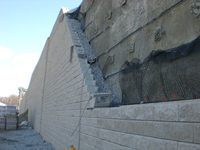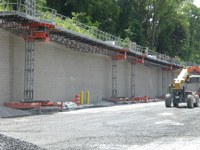Technical Newsletter
Issue 22
Project Information
Name: CSX Intermodal Facility
Worcester, MA
Product: AB Collection
Size: 110,000 sq ft. (10,200 m²)
Local Engineer: Clark Geotechnical, Woodstock, GA
Wall Builder: Vermont Lumber and Stone (VLS), Nashua, NH


Did you know OSHA Standards require a guard rail to be placed when working at or above 6 feet (1.8 m)?
OSHA also requires these guard rails to carry a load of not less than 200 lbs (0.88 kN) that extend the entire length of the unprotected edge.


Site Problems Tackled with Allan Block Versatility
When CSX Intermodal Facility in downtown Worcester, MA needed to expand their property for new rail lines, multiple issues were encountered. With a local roadway at the top of the nearby hillside as well as utilities directly behind the proposed wall, this project presented numerous challenges to both the design and construction of the retaining wall.
Initially, the plan was to use shotcrete and soil nails for the majority of the project and only a small portion of the walls would utilize geogrid reinforced segmental retaining wall block. Problems with the site soils and the aesthetics of the proposed wall did not allow the initial design to proceed. To solve the aesthetics challenge, the overall plan was changed from having 15,000-20,000 ft² (1,400-1,800 m²) of geogrid reinforced Allan Block wall to using Allan Block to face the entire wall including the geogrid and non geogrid reinforced areas. The resulting design used Allan Block to cover all 110,000 ft² (10,200 m²) of wall which satisfied the owner’s aesthetic requirements.
Design engineer Chad Clark of Clark Geotechnical provided the final design that had portions of the wall reinforcement using sheet piles with soil nails, geogrid, as well as soil nails with shotcrete. Not only did the three different types of reinforcement need to be designed differently, VLS, who was a Certified Allan Block Contractor had to construct the different sections of the wall making the Allan Block facing appear seamless across the entire structure. In areas where sheet piles with soil nails and shotcrete with soil nail reinforcement were required, industrial strength cable was run along the entire wall to allow a connection from the Allan Block facing to the multiple reinforcement sections.
Much like the commonly used spreader bar application, the geogrid was wrapped around the cable and returned to the facing for proper connection. Since the block and grid were only acting as a facing, the Allan Block units only had to resist the bin pressure of the wall rock placed behind the segmental block. The wall rock also acted as drainage for any incidental water that migrated from the retained soil. This method of construction was used throughout the wall where geogrid reinforcement was not used to create an aesthetically appealing wall that met CSX’s requirements. See full story...
Design & Construction with Multiple Reinforcement Options
Over the years, many different types of structures have been used to retain soil and provide a working area on uneven terrain. Sheet piles, cantilever, soil nail reinforcement, and geogrid reinforcement are just a few of the options to retain soil and expand the usable area of a project. Each type of reinforcement has advantages and/or disadvantages that the site conditions will determine which application is best. In the case of CSX, sheet piles with soil nail reinforcement were required due to onsite foundation soils being poorer than the initial design and the limited room behind the wall for excavation. Typically, this is an expensive design, but the solution was the only feasible option that did not impact the roadway above the wall or the utilities that ran parallel with the roadway. Sheet piles are driven sheets of metal that use an interlocking connection to obtain a continuous barrier in the ground. With slender pile walls, additional capacity can be found by using soil nails or other tieback options to account for additional lateral and surcharge loads above the wall. Most tieback systems incorporate a high capacity wire or steel rod which relies on frictional interaction of the retained soil to overcome pullout of soil. Many tiebacks incorporate a bulb which allows greater resistance to pullout.
Soil nails with shotcrete were used in other portions of the wall on CSX where heavy vegetation above the wall did not make a geogrid reinforced wall the practical site solution. This was still more inexpensive than using sheet piles with soil nails. Shotcrete is a concrete sprayed at high velocity over steel cages or wire mesh that creates a concrete structure that can incorporate multiple types of reinforcement such as soil nails, steel mesh, or fiber reinforcement. This is still a feasible design in most applications where proper excavation cannot be done behind the structure for geogrid placement.
Whether you are designing a wall with sheet piles, shotcrete, anchors, etc., facing the wall with Allan Block is always an option. The structural component of the wall would still come from the designed retaining wall reinforcement (piles, shotcrete, etc.) and the Allan Block itself would be a facing that gives the high aesthetic value the owner requires. In these applications, the facing connection is all that needs to be designed and typically uses a spreader bar to transfer facing stability to the structural wall. A typical spreader bar option can be used to connect the segmental block wall to the retaining wall structure by anchoring a horizontal pipe (spreader bar) to the structure by a steel rod or anchor. The spreader bar allows for grid to be placed behind the block, wrap around the bar and then return to the block on the next course up. Other connection options can be used such as what was done on the CSX project. On CSX, the same connection concept was used, but instead of the spreader bar being utilized, eye hooks were placed throughout the wall which allowed an industrial cable to be tensioned on both ends. The grid was still wrapped around the cable and returned to the next course above. When the capacity of the geogrid exceeds the capacity of the cable (or spreader bar), the spacing of the cables would be dependent on the strength of the cable. Both construction methods allow proper connection to the retaining structure behind the block and gives the overall appearance to the wall as a single entity while meeting proper design requirements.
Construction Above Wall
Typically, on a construction site, access above a retaining wall allows proper excavation for geogrid or grading. Not all sites however will allow the contractor full access on top of a wall. Thus, alternative construction methods may need to be addressed. When facing a non-geogrid retaining wall with a modular block system, a wall structure such as sheet piles or an anchored wall which is carrying a load from a roadway, building, or other structure is already in place. In this case, the area behind the modular block (rock area between the wall structure and the modular block), does not allow crews easy access to stacking and compacting. Typically these types of situations would come up on large scale commercial projects where the contractor may need to incorporate a series of scaffolding systems or even a hydraulic lift. This is an item that may not be thought of during the early stages of a project but one that can become very costly to implement as the project moves forward.




